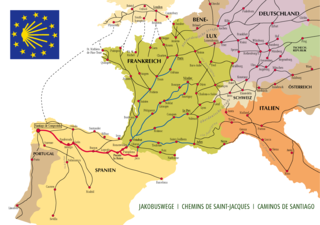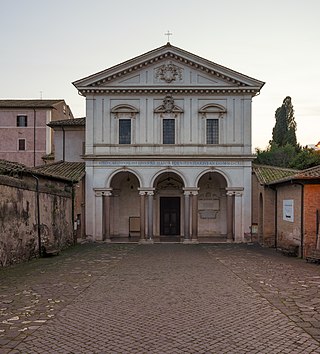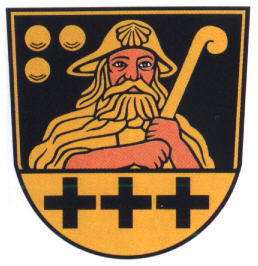
A pilgrim is a traveler who is on a journey to a holy place. Typically, this is a physical journey to some place of special significance to the adherent of a particular religious belief system. In the spiritual literature of Christianity, the concept of pilgrim and pilgrimage may refer to the experience of life in the world or to the inner path of the spiritual aspirant from a state of wretchedness to a state of beatitude.

James the Great was one of the Twelve Apostles of Jesus. According to the New Testament, he was the second of the apostles to die, and the first to be martyred. Saint James is the patron saint of Spain and, according to tradition, his remains are held in Santiago de Compostela in Galicia.

The Camino de Santiago, or in English the Way of St. James, is a network of pilgrims' ways or pilgrimages leading to the shrine of the apostle James in the cathedral of Santiago de Compostela in Galicia in northwestern Spain, where tradition holds that the remains of the apostle are buried.

The Via Francigena is an ancient road and pilgrimage route running from the cathedral city of Canterbury in England, through France and Switzerland, to Rome and then to Apulia, Italy, where there were ports of embarkation for the Holy Land. It was known in Italy as the "Via Francigena" or the "Via Romea Francigena". In medieval times it was an important road and pilgrimage route for those wishing to visit the Holy See and the tombs of the apostles Peter and Paul.

The Pilgrims' Way is the historical route supposedly taken by pilgrims from Winchester in Hampshire, England, to the shrine of Thomas Becket at Canterbury in Kent. This name, of comparatively recent coinage, is applied to a pre-existing ancient trackway dated by archaeological finds to 600–450 BC, but probably in existence since the Stone Age. The prehistoric route followed the "natural causeway" east to west on the southern slopes of the North Downs.

New Age Travellers are people located primarily in the United Kingdom generally espousing New Age beliefs with hippie or Bohemian culture of the 1960s. New Age Travellers used to travel between free music festivals and fairs prior to crackdown in the 1990s. New Traveller also refers to those who are not traditionally of an ethnic nomadic group but who have chosen to pursue a nomadic lifestyle.

San Sebastiano fuori le mura, or San Sebastiano ad Catacumbas, is a minor basilica in Rome, Central Italy. Up to the Great Jubilee of 2000, San Sebastiano was one of the Seven Pilgrim Churches of Rome, and many pilgrims still favour the traditional list.
The Confraternity of Saint James is a pilgrims' association, educational charity and book publisher for the ancient and modern-day pilgrim route Camino de Santiago or "way of Saint James" to the city of Santiago de Compostela in Galicia in northern Spain.

A pilgrim's hat, cockel hat or traveller's hat is a wide brim hat used to keep off the sun.

Bona of Pisa was a member of the Third order of the Augustinian nuns who helped lead travellers on pilgrimages. In 1962, she was canonized a saint in the Catholic Church by Pope John XXIII. She is considered the patron saint of travellers, and specifically couriers, guides, pilgrims, flight attendants, and the city of Pisa.

Religious tourism, spiritual tourism, sacred tourism, or faith tourism, is a type of tourism with two main subtypes: pilgrimage, meaning travel for religious or spiritual purposes, and the viewing of religious monuments and artefacts, a branch of sightseeing.

The Palestine Pilgrims' Text Society (PPTS) was a text publication society based in London, which specialised in publishing editions and translations of medieval texts relevant to the history of pilgrimage to the Holy Land. Particular attention was given to accounts by pilgrims and other travellers containing geographical or topographical information, as well as those which discussed the manners and customs of the Holy Land. The original narratives were written in a variety of languages, including Greek, Latin, Arabic, Hebrew, Old French, Russian, and German.
The anonymous pilgrim of Piacenza, sometimes simply called the Piacenza Pilgrim, was a sixth-century Christian pilgrim from Piacenza in northern Italy who travelled to the Holy Land at the height of Byzantine rule in the 570s and wrote a narrative of his pilgrimage. This anonymous pilgrim was erroneously identified as Antoninus of Piacenza or Antoninus Martyr out of confusion with Saint Antoninus of Piacenza, who died in 303 and is venerated as a martyr.
Daniel the Traveller, known also as Daniel the Pilgrim, Daniel of Kiev, or Abbot Daniel, was the first travel writer from the Kievan Rus. He is known for travelling to the Holy Land in the aftermath of the First Crusade and his descriptions are important records of the region during that time. Some have identified him with a certain Daniel, bishop of Yuryev between 1115 and 1122.
Allucio of Campugliano (1070–1134) was a Tuscan holy man who distinguished himself by his work on behalf of pilgrims and the poor, and for peace. In the Roman Catholic Church his feast day is celebrated on 23 October.

Ajmer Sharif Dargah is a Sufi Tomb (dargah) of the Sufi saint, Khawaja Moinuddin Chishti, located at Ajmer Shareef, Rajasthan, India.

Sæwulf was probably the first English pilgrim to Jerusalem following its conquest in the First Crusade. His Latin written account of his pilgrimage tells of an arduous and dangerous journey; and Sæwulf's descriptive narrative provides scholars brief but significant insight into sea travel across the Mediterranean to the new Kingdom of Jerusalem that was established soon after the end of the First Crusade.

The bishop of Tanis was the head of the Christian church in the ancient Egyptian city of Tanis. Although it is no longer a residential bishopric, it has been a titular bishopric in the Roman Catholic Church since the Middle Ages.
Stephen of Novgorod was a Russian traveller to Constantinople who wrote an account of the city called the Wanderer.